
The bladder after a spinal cord injury (SCI) is like a boxing punching bag at an open gym. Every day it is constantly getting hit and irritated by outside elements, such as secondary conditions (urinary tract infections/UTIs, bladder stones, bladder spasms and incontinence). The biggest culprit of constant irritation overtime comes from catheter-use. All of this makes a bladder quite unhappy, but there are steps that can be taken to lessen the impact of these secondary conditions, making a SCI bladder happier and less beat up over time.
Taking care of your bladder should be one of the most important goals of your long-term SCI health game plan. An unfortunate reality is that constant bladder irritation increases the likelihood of bladder cancer, which is one of the top causes of death among people with spinal cord injuries. In fact, those with a SCI have a 15.2 times higher rate than the rest of the able-bodied population of developing bladder cancer.
Strategic but simple steps can limit common bladder irritants, and scheduling important bladder tests each year can make a huge difference. Below you will find different tips and tricks that you both should know and think about to keep your bladder healthy, and cancer-free for years to come.
Questions to Ask and Think About
 It’s always a good idea to be your own best advocate and ask yourself important health questions to monitor the health of your bladder. Make sure to think of the following questions every 6 months:
It’s always a good idea to be your own best advocate and ask yourself important health questions to monitor the health of your bladder. Make sure to think of the following questions every 6 months:
1. What kind of catheter do I use?
2. When was the last time I saw my urologist?
3. How many times a year do I have UTIs (and require antibiotics)?
4. Does cancer run in my family?
5. Am I drinking enough water?
6. How many years have I used an indwelling catheter?
7. Is there a non-indwelling catheter option that could work for me?
8. Can another type of bladder management program help decrease UTIs and other complications?
9. Am I willing to accept a decrease in convenience or independence with a new bladder management program?
10. Is their blood in my urine on a regular basis?
Members of the SCI Community Lost to Bladder Cancer
Many prominent people in the spinal cord injury community have suddenly been diagnosed with bladder cancer and sadly are no longer with us. Here are three well known people in the SCI community who’ve passed too soon because of bladder cancer.
 Kerry McGregor: A finalist in the X Factor, a singing contest in the United Kingdom, Kerry was known for her amazing voice. She became paralyzed after falling out of the tree when she was 13. In 2010, Kerry was diagnosed with bladder cancer and fought it tirelessly. Unfortunately, she passed away in 2012. Kerry left behind a young son and also became an ambassador for the Action on Bladder Cancer before her passing.
Kerry McGregor: A finalist in the X Factor, a singing contest in the United Kingdom, Kerry was known for her amazing voice. She became paralyzed after falling out of the tree when she was 13. In 2010, Kerry was diagnosed with bladder cancer and fought it tirelessly. Unfortunately, she passed away in 2012. Kerry left behind a young son and also became an ambassador for the Action on Bladder Cancer before her passing.
 Barry Corbet: The editor of New Mobility Magazine from 1991 to 2000, Barry was one of the most accomplished adaptive skiers and filmmakers with paraplegia in United States. Before his injury, Barry was an avid mountain climber and even met President John F. Kennedy for climbing Mount Everest in 1963. In 2003, he was diagnosed with advanced bladder cancer, passing away at age 68.
Barry Corbet: The editor of New Mobility Magazine from 1991 to 2000, Barry was one of the most accomplished adaptive skiers and filmmakers with paraplegia in United States. Before his injury, Barry was an avid mountain climber and even met President John F. Kennedy for climbing Mount Everest in 1963. In 2003, he was diagnosed with advanced bladder cancer, passing away at age 68.
 Alford “Skip” Wilkins: An accomplished quadriplegic athlete in the ’70s & ’80s, as well as a motivational speaker for the newly injured and large companies; Skip died of bladder cancer in 2005. He lived a full life after his injury, receiving a degree in Psychology, publishing an autobiography called “The Real Race” and was happily married. He was also a Paralympian and a 10 time National Table Tennis Champion. Many people with a SCI have fond memories meeting Skip at various rehab facilities across the country thanks to his warm personality.
Alford “Skip” Wilkins: An accomplished quadriplegic athlete in the ’70s & ’80s, as well as a motivational speaker for the newly injured and large companies; Skip died of bladder cancer in 2005. He lived a full life after his injury, receiving a degree in Psychology, publishing an autobiography called “The Real Race” and was happily married. He was also a Paralympian and a 10 time National Table Tennis Champion. Many people with a SCI have fond memories meeting Skip at various rehab facilities across the country thanks to his warm personality.
Who’s Most Susceptible in the SCI Community?
Studies report everyone with paralysis, both male and female, have a 15.2 times higher chance of getting bladder cancer than the able-bodied population. In the general able-bodied 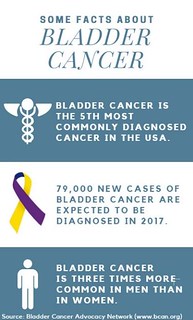 population, men have a 3% chance (1 in 27) and women have a 1% chance (1 in 84) of getting bladder cancer in their lifetime. Also, people who are Caucasian have a higher rate of bladder cancer than other races.
population, men have a 3% chance (1 in 27) and women have a 1% chance (1 in 84) of getting bladder cancer in their lifetime. Also, people who are Caucasian have a higher rate of bladder cancer than other races.
According to the National Rehabilitation Hospital, bladder cancer also occurs in people with SCI at an earlier age. For able-bodied individuals, bladder cancer usually develops in people 60+ years old, but for those with a SCI it can appear as early in peoples’ 40’s and 50’s.
Bladder cancer affects both indwelling and intermittent catheter-users. Those using indwelling catheters are 4.9% more likely to develop bladder cancer than those relying on intermittent catheterization. Long-term use of indwelling catheters, especially after 8 to 10 years, increases the risk of bladder cancer as well.
Regardless of what type of catheter you use, both indwelling and intermittent catheter-users have a greater likelihood of bladder cancer than the general able-bodied population. For this reason, everyone with a spinal cord injury, no matter the kind of catheter they use, needs to be on top of their bladder health.
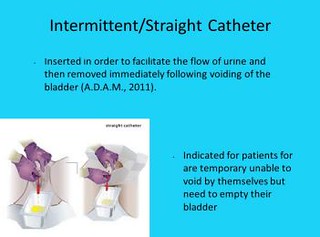
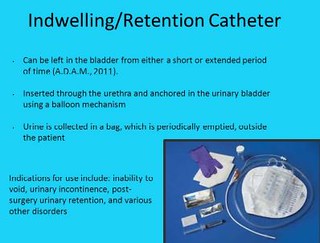
Catheters
Catheters are the largest potential source of irritation to the bladder. Those with indwelling 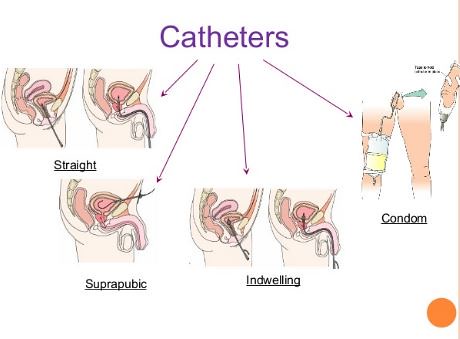 catheters need to be especially concerned about bladder irritation caused by the catheter tip and drainage eye. The catheter tip and its’ pointed end can rub and put pressure against the bladder wall, causing bladder lining damage.
catheters need to be especially concerned about bladder irritation caused by the catheter tip and drainage eye. The catheter tip and its’ pointed end can rub and put pressure against the bladder wall, causing bladder lining damage.
The Traditional Foley catheters drain through two holes at the tip. The bladder wall and bladder lining gets sucked into the catheter tip hole(s) because of the constant flow of urine traveling from the bladder to the drainage bag. This constant flow of urine creates a natural suction at the catheter tip resulting in the bladder wall/lining being suctioned into the tip causing severe irritation and potentially complete urine blockage.
To Prevent?
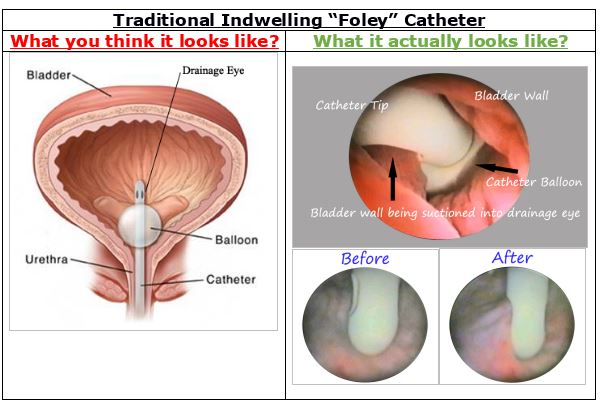
Use less irritating catheters and lubricants: Catheters that are made of softer materials and incorporate lubricant such as hydrophilic catheters are less irritating. You can also use a catheter lubricant made of numbing lidocaine jelly for the insertion process.
Change from a Single Balloon to a Dual-Balloon Catheter:
There are new indwelling catheters available with two balloons where the drainage eye tip is 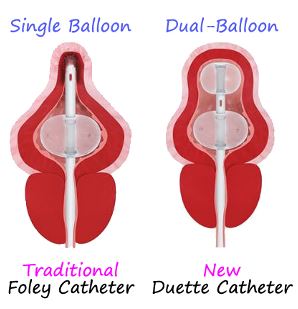 strategically placed to prevent suctioning against the bladder wall/lining. This new catheter is called the Duette and it substantially decreases catheter related indwelling bladder irritation.
strategically placed to prevent suctioning against the bladder wall/lining. This new catheter is called the Duette and it substantially decreases catheter related indwelling bladder irritation.
Learn more by visiting: http://www.poiesismedical.com/products/duette/ or by calling 561-842-7560 x504
Start with a catheterization schedule and modify as needed: Staying on a catheterization schedule for an intermittent catheter (catheterizing every 3 or 4 hours) is a good starting place to prevent an over-full bladder, autonomic dysreflexia or urinary leakage accidents. It’s important to monitor and modify your schedule by making tweaks based on your liquid consumption, type of liquid (water, soda, caffeine or alcohol) and your body’s ability to produce urine. Over time, you will have a better ability to understand your body and how fast it produces urine.
Note: Indwelling suprapubic catheters should be changed based on your urologist’s recommendation.
Sterile catheterization techniques: Assemble all urinary supplies in as sterile of an environment as possible and always wash your hands and/or have your caregiver wash their hands before catheterizing. Povidone-iodine swabsticks can be used to sterilize the insertion site before catheterization. Also, if your catheter is not pre-lubricated, it is recommended to use lubricant at the insertion site or on the catheter tip allowing for a smoother catheterization and to prevent irritation.
Anticholinergic drugs: Drugs like Ditropan, Detrol, Enablex, Vesicare tend to relax the bladder decreasing the amount of irritation the bladder wall and lining are subjected to.
Drink green tea and take vitamin E: Green tea is associated with a reduction in many types of cancers such as bladder, esophageal and pancreatic. Additionally, taking vitamin E 200 IU orally for longer than 10 years correlates to a reduced risk in bladder cancer deaths.
Switch side of leg drainage tubing/bag: To prevent constant irritation of the indwelling catheter at the same location within the bladder, it’s recommended to switch the tubing/bag from the left leg to the right leg every day. If for functional reasons you keep the drainage bag on one particular side at night, then during the day (when in your chair) switch it to the opposite side.
UTIs
Urinary tract infections are one of the top irritants of the bladder. UTI-causing bacteria is 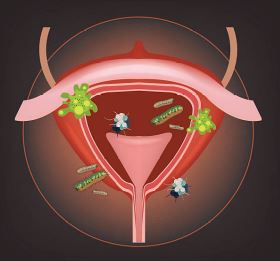 sometimes so harsh that the infection will irritate the lining of the bladder wall causing it to bleed. If you have frequent bladder infections, which many people with spinal cord injuries do, it becomes more difficult for your bladder to heal over time. Doctors think this makes the body more susceptible to bladder cancer as well.
sometimes so harsh that the infection will irritate the lining of the bladder wall causing it to bleed. If you have frequent bladder infections, which many people with spinal cord injuries do, it becomes more difficult for your bladder to heal over time. Doctors think this makes the body more susceptible to bladder cancer as well.
To Prevent?
Meticulous hygiene and proper handling of urinary drainage bags:
1. Unplug the dirty (nighttime or daytime) bag, by disconnecting the drainage tube from the catheter.
2. Attach a clean bag, tubing and connector to the catheter.
3. Completely empty urine out of dirty bag.
4. Clamp, twist or shut the bottom drainage valve to the closed position.
5. Use a small funnel or syringe to pour a mixture of water and disinfectant solution (ex. bleach) through the connector and tubing into the bag (1 part disinfectant to 8 to 10 parts water – less water makes for a stronger disinfectant, but too strong a solution can damage your skin on contact).
6. Shake bag gently so solution cleans all parts of the inside of bag.
7. Open drainage valve to empty solution from bag.
8. Wash off outside of bag with fresh solution.
9. Repeat steps 4-8 using water without solution.
10. Hang bag up to dry.
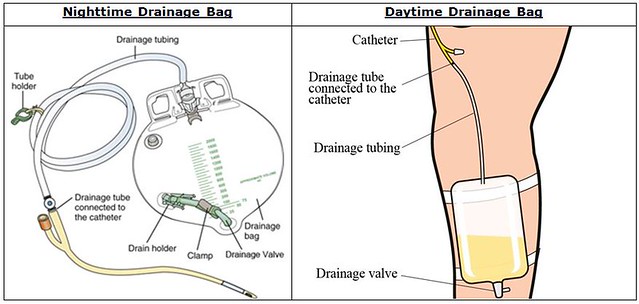
It’s important that you clean your urine drainage bag each day, and check your tubing and connectors every 2 to 3 days for sediment buildup. If you see mineral buildup after cleaning, soak the tubing and connector in a bacteria killing solution for 6-8 hours. If this does not remove the buildup, replace the tubing or connector.
 Drink Water: It is super important to drink plenty of water each day to prevent UTI’s. Drinking at least 3 quarts of water each day will help to continuously flush your bladder (from Craig Hospital).
Drink Water: It is super important to drink plenty of water each day to prevent UTI’s. Drinking at least 3 quarts of water each day will help to continuously flush your bladder (from Craig Hospital).
Effective bladder drainage: It is important to empty a SCI bladder before it becomes completely full. An over-full bladder leads to an increase of pressure inside the bladder, imagine an over-full water balloon. This results in bladder wall over stretching and bladder lining damage. This bladder wall/lining damage and irritation allows for easier attachment of bacteria to the bladder wall leading to replication and colonization of a UTI. A healthy undamaged bladder wall provides a natural defense layer of protection lessening the likelihood of bacterial attachment, replication and colonization.

Bladder Stones
Bladder stones are not surprisingly another bladder irritant. People with spinal cord injuries have a higher rate of bladder stones, which frequently rub/scratch the lining of the bladder causing irritation and bleeding.
To Prevent?
Hydration and bladder drainage: Drinking lots of water and constantly draining your bladder pushes out sediment buildup in the bladder. If the bladder is not drained in a timely manner, over time sediment in the bladder can stick to each other and slowly form stones.
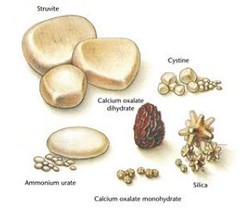
Annual Tests: Ultrasounds, X-Rays, CT scans and/or Cystoscopy. Ask your doctor which of these tests is best for you. More information on these tests is found below.

Performing these tests on a constant basis provides an opportunity for your urologist to locate stone formation before they get too big. If the stones are small enough, your urologist can use a bladder stone basket extractor to pull out the small stones through your urethra. Otherwise, a further surgical procedure must take place involving anesthesia. Hand-held lithotripters use ultrasonic energy to break up the stone into pieces small enough to pass in the urine. Holmium laser lithotripsy uses a laser to break up the stone(s).
Smoking
Smoking is another big irritant of the bladder. Studies have identified smoking as a major risk factor for bladder cancer. Smokers are 2 to 3 times more likely to get bladder cancer than those that do not smoke. Studies have discovered that the Nicotine excreted from the lungs is emptied into the bladder, which causes bladder irritation. Additionally, carcinogens absorbed by the body from cigarette smoke are found in the urine.
To Prevent?
Simply put, stop smoking: This is a lot easier to say or to write than do because of the super addictive nature of cigarettes and its chemicals. Thankfully, smoking is not an SCI complication but rather a life choice.
Try prescription nicotine replacement therapy: Stopping a cigarette habit is becoming more doable thanks to medications that prevent cravings without Nicotine like Chantix. Zyban and Wellbutrin — all of which can be prescribed.
Bladder management video from the Christopher & Dana Reeve Foundation
Important Bladder Tests
There are several tests urologists recommend patients with a SCI undergo each year. These tests look for everything from bladder stones to bladder cancer. They are as follows:
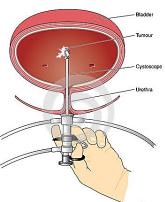 Cystoscopy: A cystoscopy is an outpatient procedure where a urologist inserts a thin tube with a camera and light on the end of it, into your urethra. Water is added to fill and extend the bladder wall for easier examination. Your urologist then looks around for stones or anything that looks worrisome (especially on the bladder walls). If you do not have stones often, it’s ok to get this done annually or every two years; however, those with a history of frequent bladder stones should consider getting this done at least twice a year.
Cystoscopy: A cystoscopy is an outpatient procedure where a urologist inserts a thin tube with a camera and light on the end of it, into your urethra. Water is added to fill and extend the bladder wall for easier examination. Your urologist then looks around for stones or anything that looks worrisome (especially on the bladder walls). If you do not have stones often, it’s ok to get this done annually or every two years; however, those with a history of frequent bladder stones should consider getting this done at least twice a year.
Ultrasound: Having an ultrasound done on your kidneys, bladder and ureters is a common scan many urologists recommend because of the low radiation it emits. An ultrasound, which bounces sound waves off organs and structures in your body to create pictures, can help your doctor detect bladder stones. The images are grainy, but they can reveal stones.
X-Ray: A kidney-ureters-bladder (KUB) X-ray is another test your urologist will order. This test also looks at the three areas where bladder stones and other bladder related conditions flare up, and it’s in black and white. Some stones are not visible on conventional X-rays.
Computerized tomography (CT): A Special CT scan will be ordered to assess for bladder cancer. This can detect large cancers in the bladder, but not small cancers. This scan is good at looking at the kidneys, ureters, and lymph nodes to see if there is any spread of your cancer or cancer in other locations. CT can detect even very small stones and is considered one of the most sensitive tests for identifying all types of bladder stones. Many urologists limit CT scans on a regular basis however due to the high radiation emitted during the test.
Urine Test: There are two different tests you can request your urologist do each year to catch bladder cancer early. One test is called Urinalysis, which checks the urine for blood (this can be an early sign of cancer). Another test is called a Cytology test. This is when the doctor looks for cancer cells in the urine under a microscope.
Types of Bladder Cancer
There are three different types of bladder cancer. A key takeaway is that the most common cancer of the bladder occurs in the lining of the bladder. Keep this in mind when getting future bladder tests.
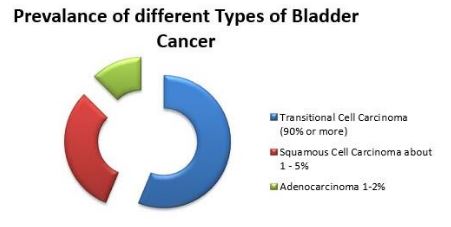
– Urothelial (Transitional Cell) carcinoma: This type of bladder cancer is the most common. Transitional cells line the urinary tract, the bladder lining and expand when your bladder is full and contracts when it is empty. This type of cancer occurs in 90 percent of bladder cancer patients.
– Squamous cell carcinoma: This is the type of cancer that occurs when a bladder is irritated and inflamed over an extended period of time, and this occurs in 4% of bladder cancer cases. The tumor/odd cell development isn’t always cancerous, but can become so over time.
– Adenocarcinoma: This type of cancer is the third most common, and it develops from the glands and glandular cells. 2% of bladder cancer is this type of cancer.
After a SCI, the notion of bladder cancer can be scary, but don’t let this fear stop you from caring altogether. It is not a lost cause! Your bladder is a long-term investment, take care of it through regular prevention methods, tests and follow-ups!
Sources:
https://craighospital.org/resources/bladder-cancer
https://www.nature.com/articles/sc2013119
https://www.unitedspinal.org/resource-center/askus/index.php?pg=kb.page&id=249
https://www.cancer.net/cancer-types/bladder-cancer/introduction
Disclaimer:
The content shared within this blog post is intended for general informational purposes only and is not a substitute for professional medical advice or treatment for specific medical conditions. You should not use this information to diagnose or treat a health problem or disease without consulting with a qualified healthcare provider.


 Older Posts
Older Posts








